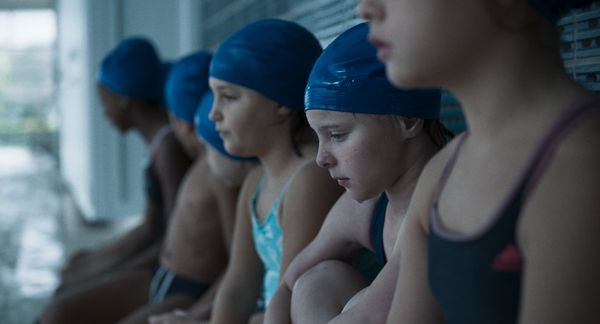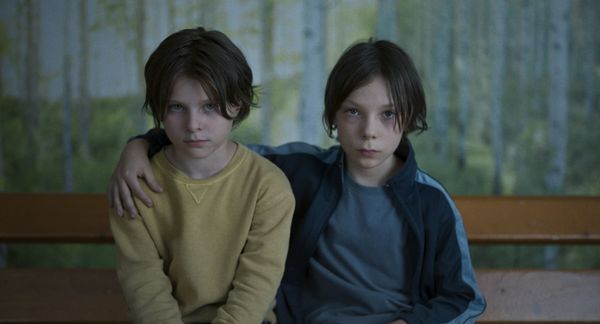 |
| Maya Vanderbeque, second left, as Nora in Playground Photo: New Wave |
You offer a real child's eye view of the schoolyard, was this the sort of thing you remembered from your own experience?
Laura Wandel: It's a mixture of my own personal experience and what I observed after spending months observing in the schoolyard. My experience when I went to school was different from the experience now, so it's a mixture of the two. I also interviewed primary school teachers and primary school heads and asked a lot of questions to start with a very wide field division, and then I narrowed it down to the one in the film.
How was working with the children - did you take a documentary approach to some of the more fun 'game' playing we see in the film rather than a scripted approach?
LW: It is a mixture but the children never saw the scenario, they never saw the script. So if it's a very, very long process. After they were cast, I worked with different groups of children - the brother and sister, the groups of friends and then much larger groups. I explained the start of a situation and encouraged them to develop that by asking what might have happened next, but I was trying to guide them at the same time so that it was in the direction I wanted to go in. So that was the start. Then the second stage was they were encouraged to improvise and develop the scene. And then we moved on from there to actually drawing the scene so that they had a visual record for themselves of all their scenes. So, if I said, "Okay, scene number 10." they already had their own visual representation and they had already personalised that. Even at that point, when they had their own scenario, I encouraged them to improvise again, so that they were going further and further and further into the scenario.
 |
| Nora (Maya Vanderbeque) faces a moral dilemma when her brother Abel (Günter Duret) starts to be bullied Photo: New Wave |
Your young stars are very good, how hard was it to cast the film?
LW: The process started simply with an ad and about 200 children came forward and we saw them. But I knew from the start that the person who played the main character, Nora, had to be very strong and solid. When Maya Vanderbeque came forward, she had no experience whatsoever but she said, "I want to give all my strength to this film". That was her approach immediately.
You take an interesting perspective in the film - not just by getting down to a child's height, but also by being at one step removed from the bullying, so we see the moral quandary Nora finds herself in - was that something you imagined from the start of the project?
LW: I knew right at the start of the project that I wanted to take the position of the witness because, in reality, in a situation like a school playground, there's a witness, there's a bully and there's a victim so I wanted to stay in the position of as a witness so that's where the feeling of distance comes from. The position of the witness is the closest to being a spectator of the film - I wanted the person watching to have the same experience as Nora so that the feeling of Nora's internal conflict of being a witness and her moral dilemma is represented and we can feel all of that internal conflict. It was very important for the violence not to be seen straight on, but just off at a tangent. It was important for me that the violence was off-screen because so much violence is in our faces at the moment. The idea was that the violence was suggested but not observed. Images of violence are everywhere and it was also a way of resisting and being different from just presenting images of violence again and again. It was so that the film audience can feel their own violence and project that as well. So it's speaking to violent impulses in the person who's watching the film.
There's a sense of adults playing by a different set of rules to the children - the grown ups see everything by the book whereas the children's movement between kindness and cruelty is much more fluid.
LW: The barrier between being the bully, the witness and the victim is very fluid and that probably everybody, in their own way, has moved from one or the other and back and through and on and on. So everybody's lived through that experience. The world of the child is also reflecting the world of adults and the film is somewhere between the two.
 |
| Laura Wandel: 'The position of the witness is the closest to being a spectator of the film - I wanted the person watching to have the same experience as Nora' Photo: New Wave |
Do you think more could and should be done to stop this sort of toxicity in playgrounds?
LW: When a child becomes violent, it's always in response to some kind of suffering, some kind of emotional wound and it's our job as adults to be at a child's level and to listen. Society moves very quickly now and very often we just don't seem to have the time to listen. I believe my role is to show what is happening and to make people see it but not to suggest any responses. It's to show the situation.
How does it feel to be selected to be Belgian's entry for the International Feature Film Oscar with your first film?
LW: I'm extremely proud to be nominated for an Oscar because it's a film which is 100 percent Belgian and, not only that, it's financed from both parts of Belgium, the French and the Flemish. It's really important for me that they can be shown to work together and collaborate on one film.
Are you working on future projects or concentrating on Playground at the moment as it comes to cinemas?
LW: I do have another project that I'm thinking about, but not really the time to dedicate to it at the moment because this film is coming out in several different countries and I want to go with the film as much as possible.
- Playground will be released in UK cinemas on April 22.
Thanks to Sylvia Davidson for translation





















